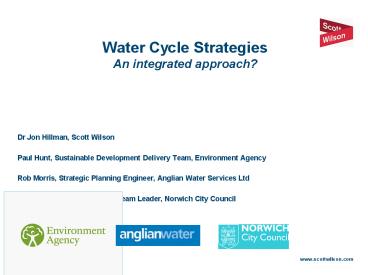Water Cycle Strategies An integrated approach - PowerPoint PPT Presentation
1 / 17
Title:
Water Cycle Strategies An integrated approach
Description:
Paul Hunt, Sustainable Development Delivery Team, Environment Agency ... Extreme events fluvial & pluvial. Water environmental impacts. Energy use & sustainabilty ... – PowerPoint PPT presentation
Number of Views:58
Avg rating:3.0/5.0
Title: Water Cycle Strategies An integrated approach
1
Water Cycle Strategies An integrated approach?
- Dr Jon Hillman, Scott Wilson
- Paul Hunt, Sustainable Development Delivery Team,
Environment Agency - Rob Morris, Strategic Planning Engineer, Anglian
Water Services Ltd - Mike Burrell, Planning Policy Team Leader,
Norwich City Council
2
Background
- 3 million new houses will be built by 2020
(Housing Green Paper, CLG (2007)) - Raw water resources, treatment distribution
- Wastewater collection, treatment discharges
(waterbody physical chemical capacity) - Extreme events fluvial pluvial
- Water environmental impacts
- Energy use sustainabilty
- Location timing of building programme location
timing of water planning infrastructure
3
Potential WCS benefits
- a method for determining when and where
sustainable water infrastructure is needed - to ensure planning makes best use of
environmental capacity and opportunities, and
adapts to constraints - a way for stakeholders to interact, preventing
any unexpected obstacles to growth - process that brings all available knowledge and
information together to help make better, more
integrated, risk based planning decisions
4
Where do WCS fit in?
5
Three stages
6
Delivery mechanisms timelines
7
Source Environment Agency, (2008)
8
Water Resources and Water Supply
- Demands
- Existing Water Resources
- Future WR schemes
- Water Efficiency
- Costings
9
Water Quality and Wastewater
- Wastewater Treatment Capacity
- Sewer Network Capacity
- River Quality Standards
- WFD
- Watercourse capacity (flood risk)
10
Is WwTW assessment detailed enough? e.g.
phosphorus
11
Suggested amendments
Yes
Yes
12
P have we got the mix correct?
13
P contribution and seasonality of point and
diffuse sources
River flow
River flow
Contribution to water column concentration
(Mainstone et al. 2000)
14
Flood Risk to development and Flood Risk
Management
- Fluvial flooding
- Tidal flooding
- Other flooding sources e.g. DG5 Register
- SUDS
- Climate Change
15
PATHWAY Overland flow
PATHWAY Overland flow
PATHWAY Overland flow from adjacent areas
16
Conclusions challenges
- Timescales
- Integration with AMP, WRP, WFD RBMP (POMS)
- Provision of data
- Key stakeholders need to be active from brief to
completion - Scale
- WCS briefs need to be drafted with water
specialists to ensure a coherent, catchment
orientated approach - For some areas, a Regional Water Cycle approach
may be the way forward
17
Thank-youJonathan.Hillman_at_scottwilson.com































